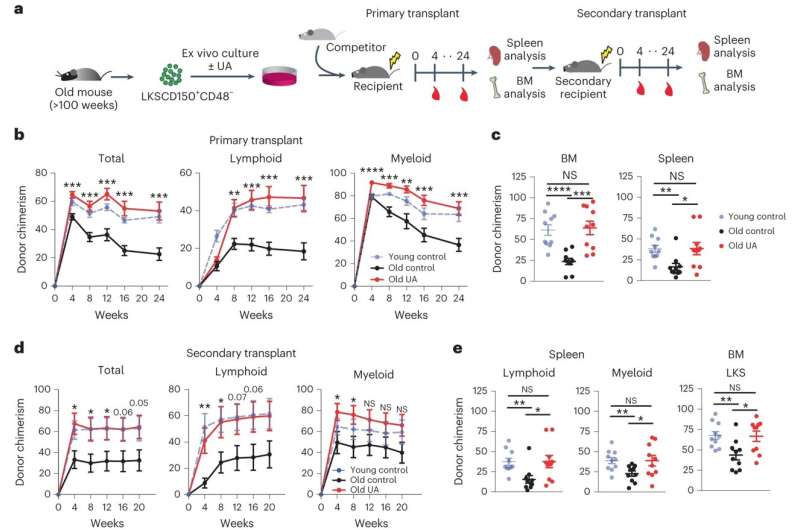This article has been reviewed according to Science X's editorial process and policies. Editors have highlighted the following attributes while ensuring the content's credibility:
fact-checked
peer-reviewed publication
trusted source
proofread
New study: Reversing aging in the blood stem cells and the immune system

As we age, our bodies face numerous challenges, including a decline in immune system function and an increased vulnerability to various health issues. An innovative study has recently shed light on these challenges and unveiled a potential solution that could have far-reaching implications for aging individuals.
The aging process is often accompanied by a decline in the proper functioning of the hematopoietic and immune systems, making older adults more susceptible to infections, blood disorders, and even tumor development.
The study published in the journal Nature Aging, led by Nicola Vannini, group leader in the Department of oncology UNIL-CHUV in Lausanne (CH) and member of the Lausanne branch of the Ludwig Institute for Cancer Research, focused on a key player in the blood system—hematopoietic stem cells (HSCs).
These cells are responsible for generating various types of blood cells, playing a critical role in maintaining a healthy immune system. As we age, HSCs experience a decline in their ability to regenerate blood and show a preference for a specific type of cell lineage, which contributes to immune system dysfunction.
Unveiling the mitochondrial connection
However, the researchers discovered a remarkable solution. By introducing a naturel compound called Urolithin A, which targets mitochondria—the energy powerhouses of cells—they were able to reverse the decline in HSC function. Mitochondria abnormalities were identified as a contributing factor to the aging of HSCs. Urolithin A acted as a mitochondrial modulator, effectively restoring the mitochondrial function within HSCs.
Urolithins are not found in food; however, their precursors are. Urolithin A is the result of transformation of ellagic acids and ellagitannins by the gut microflora in humans. Ellagitannins are found in pomegranates, nuts, some berries.
Promising results in aging mice
The most interesting finding of this preclinical study was that this intervention not only rejuvenated the blood reconstitution capability of older HSCs but also improved immune system function in aged mice. When Urolithin A was incorporated as a dietary supplement, it not only revitalized the immune system's lymphoid compartments but also enhanced overall HSC performance.
This translated to an improved immune response against viral infections, showcasing the potential of Urolithin A to combat age-related immune system decline.
In essence, this research indicates that by encouraging the recycling of mitochondria using Urolithin A, it is possible to reverse the aging process within the hematopoietic and immune systems. These findings hold immense promise for the development of interventions targeted at addressing age-related health conditions in older individuals and pave the way for envisioning clinical trials.
More information: Mukul Girotra et al, Induction of mitochondrial recycling reverts age-associated decline of the hematopoietic and immune systems, Nature Aging (2023). DOI: 10.1038/s43587-023-00473-3




















